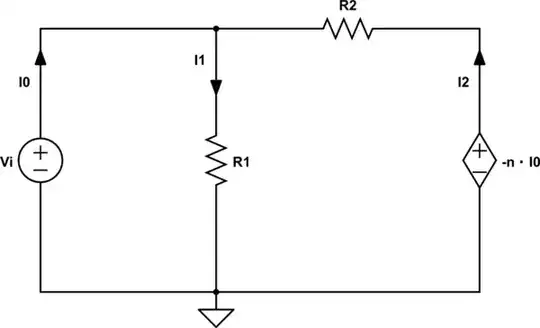Looking at the diagram below, I see the formation of a supernode that is different from the ones I've encountered before and I really don't know how to go about it.
How can nodal analysis be used to solve this circuit?
Looking at the diagram below, I see the formation of a supernode that is different from the ones I've encountered before and I really don't know how to go about it.
How can nodal analysis be used to solve this circuit?
Take the node 'b' to be the reference. Apply KCL at node 'a'. You will get an equation with two unknowns: 'io' and 'i1'. Also, in the left loop, i1=-io. You now have two equations and two unknowns. Solve this to get the values of the unknowns.
Well, the circuit we want to analyze is given by:

simulate this circuit – Schematic created using CircuitLab
When we use and apply KCL, we can write the following set of equations:
$$ \text{I}_1=\text{I}_0+\text{I}_2\tag1 $$
When we use and apply Ohm's law, we can write the following set of equations:
$$ \begin{cases} \begin{alignat*}{1} \text{I}_1&=\frac{\displaystyle\text{V}_\text{i}-0}{\displaystyle\text{R}_1}\\ \\ \text{I}_2&=\frac{\displaystyle\left(-\text{n}\cdot\text{I}_0\right)-\text{V}_\text{i}}{\displaystyle\text{R}_2} \end{alignat*} \end{cases}\tag2 $$
Using \$(2)\$ we can rewrite \$(1)\$ as follows:
$$ \frac{\displaystyle\text{V}_\text{i}-0}{\displaystyle\text{R}_1}=\text{I}_0+\frac{\displaystyle\left(-\text{n}\cdot\text{I}_0\right)-\text{V}_\text{i}}{\displaystyle\text{R}_2}\space\Longleftrightarrow\space\text{I}_0=\frac{\displaystyle\frac{\displaystyle\text{V}_\text{i}}{\displaystyle\text{R}_1}+\frac{\displaystyle\text{V}_\text{i}}{\displaystyle\text{R}_2}}{\displaystyle1-\frac{\displaystyle\text{n}}{\displaystyle\text{R}_2}}=\frac{\displaystyle\text{V}_\text{i}\left(\text{R}_2+\text{R}_1\right)}{\displaystyle\text{R}_1\left(\text{R}_2-\text{n}\right)}\tag3 $$